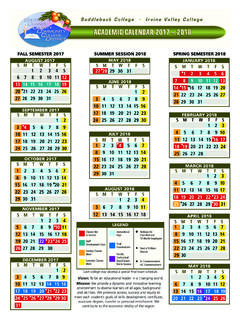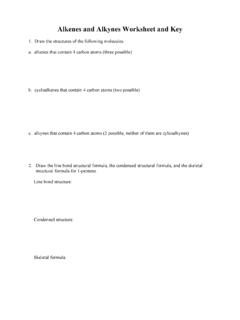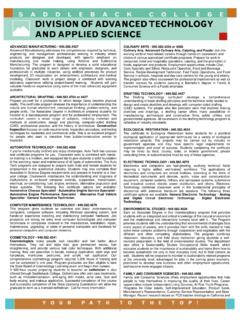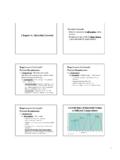Transcription of Chapter 15 Lecture Notes: Metabolism - Saddleback College
1 Chapter 15 Lecture notes : Metabolism Educational Goals 1. Define the terms Metabolism , metabolic pathway, catabolism, and anabolism. 2. Understand how ATP is formed from ADP and inorganic phosphate (P ), and vice versa. i 3. Understand how Coenzyme-A is used to transfer acyl groups. 4. Understand the roles of the NAD /NADH and FAD/FADH coenzymes in the transfer of electrons. +. 2. Identify the oxidized and reduced form of each of these pairs. 5. Understand the differences between linear, circular, and spiral metabolic pathways and give an example of each. 6. Name the products formed during the digestion of polysaccharides, triglycerides, and proteins, and know the part(s) of the digestive track where each occurs. 7. Identify the initial reactant and final products of glycolysis, and understand how this pathway is controlled.
2 8. Understand and compare glycolysis and gluconeogenesis pathways. 9. Know the fate of pyruvate under aerobic and anaerobic conditions. 10. Define the terms hyperglycemic and hypoglycemic. 11. Understand how the body controls blood glucose concentration by the release of insulin or glucagon into the bloodstream. 12. Understand and compare glycogenesis and glycogenolysis. Understand how these processes are involved in maintaining normal blood glucose concentration. 13. Understand and compare type I, type II, and gestational diabetes. 14. Identify the initial reactant and final products of the citric acid cycle; understand how this pathway is controlled. 15. Understand how the oxidation of coenzymes during oxidative phosphorylation is used to produce ATP. 16. Compare the malate-aspartate shuttle and the glycerol 3-phosphate shuttle and understand their significance in affecting the amount of ATP that can be produced from glucose.
3 17. Predict how many ATP are formed when acetyl-CoA undergoes stages 3 and 4 of catabolism. 18. Describe the catabolism of triglycerides, the -oxidation spiral, and how -oxidation differs from fatty acid anabolism (biosynthesis). 19. Given the structure of a fatty acid, predict how many ATP are formed when it undergoes the -oxidation spiral. 20. Understand and compare lipolysis and fatty acid synthesis. 21. Explain the biological origins of ketosis and ketoacidosis. 22. Understand how transamination and oxidative deamination are involved in the catabolism of amino acids. 23. Given the structure of an amino acid and -ketoglutarate, predict the products of a transamination reaction. 24. Explain how quaternary ammonium groups (-NH ) are removed from amino acids and eliminated 3. +. from the body. 1.
4 An Overview of Metabolism _____ is defined as the entire set of life-sustaining chemical reactions that occur organisms. These reactions number in the thousands and include reactions such as those responsible for getting energy from food, processing and removal of waste, building up muscles, growth, photosynthesis in plants, cell division, and reproduction. The entire set of metabolic reactions is organized into smaller sets of sequential reactions called metabolic _____. The species produced in the various reactions of a metabolic pathway are sometimes referred to as _____. Many of the reactions in metabolic pathways require enzymes; therefore organisms can control (accelerate or suppress) metabolic pathways, according to their current needs, by upregulating, downregulating, inhibiting, or activating one or more of the enzymes involved in the pathway.
5 Metabolic pathways can usually be classified as catabolic (catabolism) or anabolic (anabolism). Catabolic pathways involve the _____ of larger organic compounds into smaller compounds. Anabolic pathways involve _____ _____ of larger organic compounds from smaller ones. In this Chapter , you will learn about the pathways that are involved in the Metabolism of carbohydrates, proteins, and fats. An ultimate goal of these reactions is to convert the chemical potential energy contained in food into chemical potential energy in the form of _____. The Coenzymes Involved in Metabolism A coenzyme is a species that must bind to an enzyme in order for the enzyme to function. In most cases, a coenzyme is actually one of the substrates (reactants) in the catalyzed reaction. The reason that certain substrates are also referred to as coenzymes is that these substrates are common substrates in many different enzymatic reactions in which they donate electrons, atoms, or groups of atoms to other substrates, or accept electrons, atoms or groups of atoms from other substrates.
6 The five group-transfer coenzymes that are central to the Metabolism of food, along with the species each transfers are listed in the table on the right. 2. Phosphoryl Group-Transfer Coenzymes: ATP and ADP. ATP and ADP are classified as coenzymes because they are involved in the transfer of _____. groups (PO3-) in many different enzymatically catalyzed reactions. When a compound gains/accepts a phosphoryl group in a reaction, we say that the compound became phosphorylated.. When a compound loses/donates a phosphoryl group in a reaction, we say that it was dephosphorylated.. ATP and ADP are interconverted by the transfer of a phosphoryl group, as shown below. Adding a phosphoryl group to ADP _____ energy. Removing a phosphoryl group from ATP _____ energy. ATP is often formed by the reaction of ADP with hydrogen phosphate (HPO42-) and an H+ ion, as shown below.
7 Biological literature refers to hydrogen phosphate as _____ phosphate (abbreviated as P ). i Another way that organisms convert ADP to ATP is by the reaction of ADP with an _____. molecule that contains a phosphoryl group. In this case, a phosphoryl group is transferred from the organic molecule to ADP, as shown in the chemical equation below. You will see hydrogen ions (H+) as reactants in many of the reactions in this Chapter . Because these reactions occur in aqueous solutions, H+ is readily available from H2O, and can also come from H3O+ or the acid forms of other species that are present. 3. Energy is released from ATP when it is converted to ADP. This energy is used by organisms to drive energy-requiring reactions or physical processes that would otherwise not occur spontaneously. One way that energy can be released from ATP is by reacting it with H2O to form ADP, inorganic phosphate, and an H+ ion.
8 Although this reaction is spontaneous ( G is negative), the reaction rate is quite slow, therefore organisms employ enzymes in order for the reaction to proceed at a useful rate. The chemical equation for this reaction is shown below. Note that H+ is produced in this reaction. You will see H+ ions as products in many of the reactions in this Chapter . Keep in mind that the H+ ions that are produced in aqueous solutions do not remain solvated as isolated ions; they quickly react with water to form H3O+. Alternatively, H+ can react with OH- or the base form of another species that is present. Another way that organisms extract energy from ATP is to energize organic compounds by transferring a phosphoryl group directly to the compound. In this reaction, ATP is dephosphorylated and an organic compound is phosphorylated, as shown in the reaction below: ATP + organic compound ADP + phosphorylated organic compound + H+.
9 Chemical potential energy released by the conversion of ATP to ADP is transferred to the phosphorylated organic product. It is for this reason that we say the organic compound is energized in the reaction. Example: In this particular reaction, the reverse reaction occurs so slowly that it is negligible. In such cases, we refer to the reaction as an _____ reaction.. When writing a chemical equation for an irreversible reaction, only a forward (left to right) arrow is used, as shown above. Biochemical literature often uses an alternative chemical equation format. For example, the reaction shown above is often written as: 4. Electron-Transfer Coenzymes and Their Role as Oxidizing and Reducing Agents Oxidation-reduction reactions, which involve the transfer of one or more electrons, are quite common in organisms.
10 Many of these reactions involve the transfer of an electron by way of the hydride ion (H:-). A reduction occurs when a _____ ion forms a bond with an organic compound. The transfer of a hydride ion is a reduction because of hydride's extra electron. For example, aldehydes or ketones are reduced when a hydride ion forms a bond with them. a ketone an alcohol An oxidation occurs when a hydride ion (H:-) and an H+ ion are removed from an organic compound. For example, 2o alcohols can be oxidized to ketones, as shown in the chemical equation below. an alcohol a ketone This is considered an oxidation because the hydride ion carries away the extra electron. Nicotinamide adenine dinucleotide (NAD+) and flavin adenine dinucleotide (FAD) are classified as coenzymes because they are common substrates, involved in the transfer of _____, in many different enzymatically catalyzed reactions.











